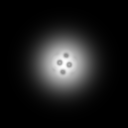Drifting Hexagons
Introduction
In a nonlinear optical system with single-mirror feedback several experiments
displayed stationary hexagonal patterns. A linear stability analysis, however,
predicts stationarity only for a perfectly aligned mirror, while drifting
patterns are expected even for an arbitrarily small misalignment. Performing
a study of the situation for small tilt angles we observe that the patterns
remain stationary up to a critical value of the angle alpha (locking) and
discontinuously start to drift as a whole if alpha is exceeded. Above this
threshold the drift velocity depends linearly on the tilt angle. Both features
are reproduced by numerical simulations with a Gaussian input beam. The
existence of the locking region can be traced back to the boundary
conditions imposed by the spatially limited input beam.
Increasing the mirror tilt even further leads to a different pattern
which moves in opposite direction to the former one. This new pattern which
resembles a squeezed hexagon becomes stationary in a second locking region
at nonzero tilt angle.
Experimental Observations
The moving GIF on the left shows a slow motion of the intensity pattern
on a CCD-camera. The hexagonal pattern moves very fast in one direction.
With appropriate fast cameras and video synchronisation circuitry it is
possible to resolve the underlying pattern. Observed with a slow camera
you see only the time integrated picture on the right. The pattern drifts
due to a misalignment of the feedback mirror in a typical single-feedback-mirror
experiment with sodium vapor as nonlinear medium.
Computer Simulations

This moving GIF shows the results of a numerical (computer-) simulation
in order to proof the model equations with which we try to understand the
experimental observations like the one below. As you can see, we find drifting
hexagons inside a Gaussian beam profile as well. Furthermore the parameters
of the calculation are derived from typical experimental situations. If
you have a closer look, you might also notice a difference between experiment
and simulation, namely the tendency of the simulated hexagonal patterns
to alter their orientation.
The direction of the drift follows the direction of the misalignment
of the feedback mirror (which is simulated by a displacement). Shown here
is the full numerical grid of the simulation.
 List of publications List of publications
|

